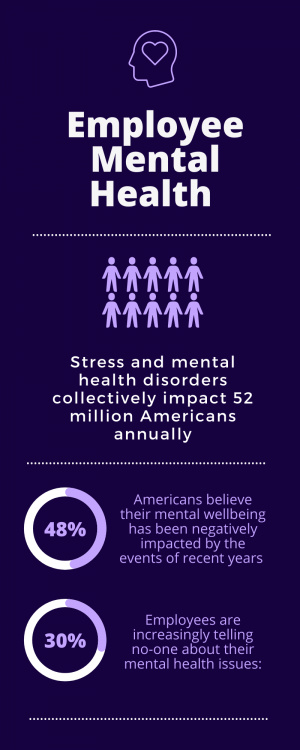10 Ways to Improve Employee Mental Health and Why It Matters

Poor mental health can impact productivity, communications, engagement, and other core business areas. The workplace has been identified as a key location for activities that can improve employee wellbeing, and with obvious gains in enhanced morale, productivity, loyalty, and more, there is a concrete justification to support or start a workplace wellness program.
In this post, we look at why employee mental health matters, and outline fundamental steps to take to effectively support the mental wellbeing of your staff.
Employee Mental Health in America
Stress and mental health disorders collectively impact 52 million Americans annually, a figure that will have increased over the past 18 months. As businesses closed, schools shut down, remote working became the norm, and people faced long periods of isolation; this placed higher than average levels of stress on society at large.

Close to half of all Americans believe their mental wellbeing has been negatively impacted by the events of recent years, and although the long-term implications of the pandemic aren’t realized just yet, wellbeing and mental health is a key element of the recovery process. Some employers have reported a growing reluctance from staff to come back to the office, and after prolonged periods of isolation and uncertainty, an increasing number of people are faced with mental health issues that were not present in their lives before COVID-19 arrived.
Research has been published about the impact of wellness programs in FTSE 100 companies. This found that businesses with established wellness and employee engagement programs consistently outperformed those without by 10%.
With an undeniable link between business performance and motivated staff who are focussed, healthy, and feel valued; companies are compelled to strengthen their efforts and turn a greater level of focus toward wellbeing and engagement.
Why is Employee Mental Health So Important?
Research indicates that businesses with higher levels of mental health awareness are more successful. Figures vary slightly, but wide-scale studies have shown business productivity gains of between 10-14%.
In the same way everyone has their physical health, we each have our own mental health. With both, the needle often shifts up and down. When you consider the amount of time people spend working, it’s easy to understand how much workplace culture can impact workplace wellbeing. Even for those employees who now work remotely, spending more time alone can impact how they communicate with others, how productive they are, and ultimately, how engaged they are with the business.
In times of crisis, people will always react differently. While some people are comfortable speaking about how they feel, many struggle to open up. Employers are now faced with staff who are reluctant to return to the office; many of whom, after periods of uncertainty or isolation, could now be dealing with mental health matters that were simply not present in their lives before COVID-19.
A supportive, open workplace can benefit the business, the staff, and the bottom line.

The Impact of Failing to Address Employee Mental Health
When a company fundamentally fails to address employee mental health, this can place a strain on productivity, innovation, and profitability. Below are three of the key business areas that can be impacted when employee wellbeing is not prioritized.
1. Morale
The most obvious implication of showing little concern for employee mental health is morale. This type of issue, if left unaddressed, can have a domino effect on other areas of the business. When staff morale is high, it can improve efficiencies and boost productivity. When morale is low, it impacts people (including clients), productivity, profitability; indeed, one could argue that low morale has the potential to impact the whole of the business in one way or another.
2. Staff Retention
Poor employee mental health can also impact employee retention rates. With today’s highly competitive job market, individuals have the option to choose where they want to work. When people leave your firm, having to regularly hire and train up new employees to replace those who have left can strain company resources. By taking steps to improve your focus on employee mental wellbeing, you’ll likely find that your business spends less time and money on hiring and training up new employees. Which again contributes to the overall profitability and success of the firm. Ensuring staff are working in an environment where they feel valued, supported, and part of a team are each key to staff retention.
Related: Employee Retention Strategies
3. Reputation
Whether we consider this from an employer-branding perspective or the levels of service your clients and partners receive, both can be impacted by failing to address and improve employee mental health. Indeed, a business that is known for looking after its people will often have a far better reputation among its customers than brands who do not take proactive steps to boost good employee mental health. What’s more, happy staff will often provide better customer service, which can help improve client’s experiences and interactions with your brand.
Related: How to Elevate Your Employer Brand
10 Ways to Improve Employee Mental Health
Now you know more about why promoting good employee mental health is important, we’ve compiled a list of steps you can take to improve mental wellbeing in the workplace.
#1 Promote Employee Wellbeing
Even slight changes to organizational culture can boost employee engagement and wellbeing. The first impactful change that can be made is with the leadership team. Make sure all senior leaders and managers are committed to wellness and engagement activities; help them see the benefits and understand the ‘why’ behind the changes. Choosing to call or speak in-person to staff as an alternative to email is another easy change to adopt. It can impact how valued people feel while helping to break down any perceived barriers to management.
Being respectful of a healthy work/life balance is another way to boost morale and wellbeing, while helping ensure staff can remain healthy and focussed. Leaders should role model healthy work habits.
Making sure mental health is included in a company induction program and discussing this as part of the company diversity, and equality training is another easy-to-implement best practice to promote employee wellbeing.
#2 Ask Staff What They Want
A good starting point is to ask people what they want from the business, and for staff to consider and offer suggestions about how things could be improved. Anonymity is also important when trying to get people to be honest and open.
Actions such as this only come from a business that genuinely cares about their employee wellbeing, and actively listens to suggestions from individuals about potential improvements. What’s more, it will also help prioritize any changes; and this can be one of the most effective ways to ensure your brand is implementing effective employee mental health protocols and practices.
This is another relatively easy-to-implement process, which enables a business to develop employee-focused initiatives to improve employee mental health and wellbeing.
#3 Check-In with Your Staff Regularly
We’ve mentioned the importance of asking your staff what they want from the business – in addition to this earlier point, the frequency of interactions between leaders and their people should be consistent and, wherever possible, done in-person. Email communications should be a final resort or be sent as confirmation once any important conversation has taken place.
Something as simple as a warm greeting from the boss can work wonders when your staff arrives at work. Taking time away from the desk and asking people how they are, what they’re working on, asking if they need any support, and showing a genuine interest in the individual are key. This is another relatively straightforward way to improve employee mental health; no planning is required, just time.
Ready to hire someone great?
Connect with our recruiting professionals today.
#4 Open Dialogue and Involvement
When people are involved in discussion or the actual decision-making process, they feel informed about things that are happening in the business. It can increase motivation, provide clarity, and help individuals to gain a clearer understanding of their role in the company. Being open about the direction or strategic vision for the business, asking for feedback, and listening to feedback is another way to improve employee mental health.
There are many ways to start promoting open dialogue and staff engagement; here are just a few.
- Focus Groups
- Staff Survey
- Staff Forums
- Steering Groups for Engagement
- Innovation Workshops
- Community Projects
- Regular Team Meetings
- Quarterly Business Performance Updates
- Away-Days for Staff
- Team Building Events
- Discuss Board Decisions with Staff
- Effective Use of Internal Communications
#5 Keep Up with Employee Performance
There is an undisputed connection between employee mental health and productivity at work. If you notice a dip in performance from a member of staff, it’s important to speak with them to see if they need any help. These conversations are often best had with a line manager or their closest supervisor, in the first instance.
By staying on top of employee performance, your business will be able to step in and offer support should a member of your team start to struggle. Reduced performance and productivity are key early indicators that a person could need some additional support. Make sure that leaders have easy access to this data and that they check it regularly.
Conversations with staff should be open, free flowing, and come from an authentic position of wanting to help.
#6 Invest in Learning and Development
Significant research into employee engagement and best practice tell us that people need to feel supported at work, and that they should have meaningful work to do. By providing a career pathway or a framework of opportunities for both professional and personal development to staff, it can help build integrity and trust, both of which are essential to maintaining productivity and loyalty in teams.
It’s also good to highlight that not all training and development needs to cost a significant amount of money. Coaching with a senior member of the team or job shadowing in other departments or roles often carries a very small cost to the business. Workplace mentorship programs are another great tool you can use to help improve the wellbeing and engagement of staff.
Related: How to Invest in Employee Development
#7 Arrange Events for Your Team
Work shouldn’t be all about – well, work. To promote good mental health among your employees, arranging events (for example, company meals and outings) can be an excellent way to show your gratitude for the team; while also giving staff an opportunity to develop relations with their colleagues outside the workplace. If you can arrange an off-site day, or even a half-day once or even twice a year, this is another great way to give something back, helping everyone get to know one another a little bit more, and putting morale and engagement first.
Related: Virtual Team Building Events
#8 Reward Good Work
This isn’t just about compensation; but ensuring you offer a competitive salary and reward good performance is good practice. Reward and recognition of hard work can go a long way in impacting the way people feel when they come to work. It can be something as simple as making sure your business managers thank the staff for doing a job well or highlighting an incentive they performed well in. Bringing attention to positive achievements, rewarding good work, and recognizing the individual effort being made can help with engagement, morale, retention, productivity, and motivation.
#9 Be Mindful of Workplace Triggers
There are many known triggers for mental health and stress. These include:
- Being in a high-risk role
- Working long hours or having no breaks
- Being a lone worker
- Unrealistic expectations
- Repeated unavailability for annual leave
- Unmanageable workloads
- Poorly managed business changes
- Challenging interpersonal relationships
- High-pressure work environments
- A lack of managerial support
- Lack of control over work
- Weak internal communications
- Job Insecurity
#10 Be Clear About Compensation
At the time of writing this post, there are more than 9.3 open jobs in the U.S. Aside from the shift in people asking for flexible working; employees are also demanding higher rates of pay. According to a survey of the labor market by the New York Federal Reserve, the lowest acceptable wage for those without a college degree in 2021 is around $65,000; a figure that has increased rapidly in recent years.
Making sure you offer competitive salaries and complete transparency around pay reviews can help to build trust and respect. Because money matters have the potential to impact employee wellbeing, it’s important to provide complete clarity in order to manage expectations fairly.
Checking the current state of salaries for specific roles and sectors that align with your own is a useful exercise. Even when done annually, it provides clarity on the market.
In Summary – Employee Mental Health
Good mental health in the workplace has a direct impact on both the business and its people. Whether you’ve already started taking steps to improve employee mental health or you’re doing research into your best options; there will always be an opportunity to improve upon your current position. Some of the tips we have provided do require time and consideration, but there are others that can be implemented immediately.
Changes won’t happen overnight. But with a consistent, dependable, clear commitment to the wellbeing of your staff, you can look forward to an increase in productivity, better levels of engagement, a boost in employee morale, and more fluid communications between team members.
